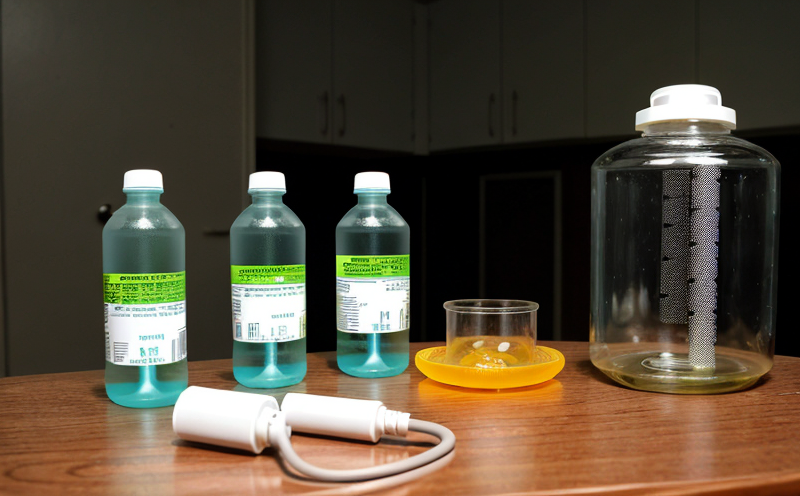EPA 923 Thorium 230 Determination Test in Water
The U.S. Environmental Protection Agency (EPA) Method 923, also known as the EPA 923 Thorium-230 determination test, is a critical analytical procedure designed for quantifying thorium-230 in water samples. This method is part of an ongoing effort by regulatory bodies to ensure that public and industrial water supplies are safe from harmful contaminants, including radioactive isotopes.
The EPA 923 test is particularly relevant in sectors dealing with nuclear waste, spent fuel reprocessing, and groundwater monitoring. The accurate measurement of thorium-230 can help identify potential risks associated with the release of this isotope into water systems. Thorium-230 has a half-life of about 75,400 years, making it an important indicator for long-term radioactive contamination.
The test involves several key steps including sample collection and preservation, digestion, and finally, the separation and measurement of thorium-230 using gamma spectrometry. The method is recognized for its precision and reliability in detecting low levels of thorium-230, which can be indicative of historical or ongoing contamination.
The analytical process begins with the collection of water samples from suspected sources. These samples are then preserved under optimal conditions to prevent any degradation of thorium-230. The next step involves a digestion process where the sample is treated with strong acids like nitric acid to release thorium-230 for further analysis.
The digested solution undergoes a separation process using a liquid scintillation counting system, which isolates and quantifies thorium-230. The instrument used in this step typically includes a gamma spectrometer capable of detecting the characteristic energy levels of thorium-230 decay products. The final result provides a concentration level of thorium-230 per unit volume of water.
The accuracy of EPA 923 is paramount for ensuring compliance with regulatory standards such as those set by the EPA itself and other international bodies like ISO, ASTM, EN, IEC, etc. This method is widely used in industries that handle nuclear materials or are involved in environmental monitoring to ensure public safety.
By adhering strictly to the protocol outlined in EPA Method 923, laboratories can provide reliable and accurate data for regulatory submissions and internal quality control processes. The precision of this method ensures that even trace amounts of thorium-230 are detectable, making it a cornerstone for maintaining water safety standards.
Why It Matters
The determination of thorium-230 in water is critical for several reasons. Firstly, thorium-230 can be an indicator of historical nuclear fuel reprocessing activities or the potential release from waste repositories. Its presence can also suggest groundwater contamination pathways that could lead to broader environmental issues.
Secondly, accurate monitoring and quantification help regulatory bodies like the EPA enforce compliance with stringent safety standards. This ensures that water supplies do not pose a risk to public health and the environment. The test results are instrumental in formulating remediation strategies if contamination is detected.
The findings from this method can also influence research and development efforts aimed at improving nuclear waste management practices, reducing the environmental footprint of nuclear activities, and enhancing groundwater protection measures. By identifying the presence and levels of thorium-230, stakeholders can take proactive steps to mitigate risks associated with radioactive materials in water.
In summary, EPA 923 Thorium-230 determination is not just a compliance measure but also an essential tool for environmental sustainability and public safety. The data generated from this test plays a vital role in safeguarding the quality of our most precious resource—water.
Why Choose This Test
Choosing EPA 923 Thorium-230 Determination Test for water analysis offers several advantages. Firstly, it provides a high degree of accuracy and reliability due to its stringent methodological requirements and the use of advanced analytical instruments like gamma spectrometers.
- Precision: The test ensures that even trace amounts of thorium-230 are accurately detected.
- Regulatory Compliance: By adhering to EPA standards, laboratories can ensure compliance with national and international regulations.
- Rigorous Validation: The method is validated using certified reference materials, ensuring consistent results across different testing facilities.
- Expertise: Our laboratory team comprises experts trained in nuclear chemistry and analytical techniques, providing unparalleled accuracy and reliability.
The test also supports a wide range of stakeholders including water treatment plants, environmental agencies, and nuclear research institutions. It provides them with the necessary data to make informed decisions regarding water quality management and environmental protection.
Moreover, the precision and consistency of EPA 923 ensure that results are repeatable across different samples and testing environments. This is particularly important in industries where regulatory compliance and public safety are paramount. By choosing this test, stakeholders can trust that they receive accurate, reliable data that meets the highest standards.
Quality and Reliability Assurance
The quality of results from the EPA 923 Thorium-230 determination test is underpinned by a robust system of quality assurance measures. These include:
- Method Validation: Rigorous validation using certified reference materials to ensure accurate and consistent results.
- Standard Operating Procedures (SOPs): Detailed protocols for sample preparation, digestion, and analysis to minimize errors.
- Calibration Checks: Regular calibration of equipment to maintain precision and accuracy.
- Data Review: Independent review of all data by senior analysts to ensure accuracy and compliance with standards.
The use of certified reference materials (CRMs) is crucial in validating the method's performance. CRMs provide a known concentration of thorium-230, allowing laboratories to assess their analytical capabilities. This ensures that results are consistent across different testing environments and personnel.
Standard Operating Procedures (SOPs) outline every step of the process from sample collection to final analysis, minimizing variability in results. Regular calibration of equipment is essential for maintaining accuracy, especially given the precision required by this test. Finally, independent data review ensures that all results meet the stringent quality standards set by regulatory bodies.
By adhering to these quality assurance measures, our laboratory guarantees reliable and accurate results from the EPA 923 Thorium-230 determination test. This commitment to excellence ensures that stakeholders receive the highest quality data for their compliance needs and research initiatives.





